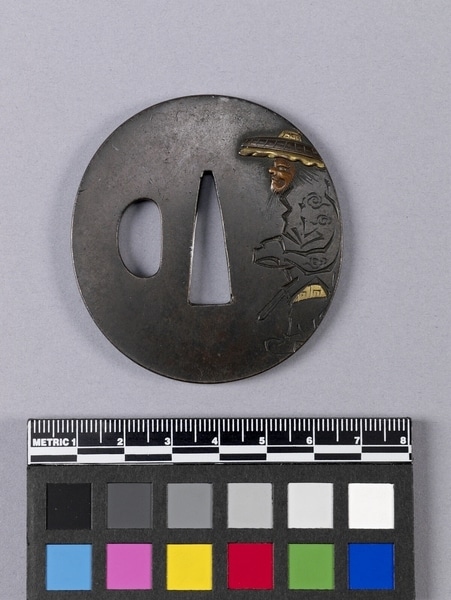Sword Guard Item Number: Ed5.3146 from the MOA: University of British Columbia


Description
Oval-shaped metal sword guard with triangular hole at centre and ovoid hole to one side. Low relief depiction of a male figure with a hat and sword in profile on one face. The figure's face is copper inlay, the beard is incised, and the hat is gold inlay. Incised tree with one branch on reverse. Made of shicuichi (bronze and silver alloy), open kodzuka, no kogai.
History Of Use
Tsuba are placed between the hilt and blade of a sword, forming an essential guard for the hand. Known to exist in Japan at least since the 8th century, they were plain unsigned metal until about the 16th century, when they became enriched artistic expressions usually made to the order of the individual warrior. The central opening, nakago ana, holds the tang of the blade and often has chisel marks or soft metal inserts as adjustments. It is surrounded by a plain surface, the seppa dai, on which the artist's signature may be found. On either side are the kodzuka and kogai openings, for a knife and a skewer respectively; when both are open the guard is intended for a wakazashi blade (less than two feet) and when one or both are plugged or absent the guard is probably intended for the longer katana blade.
Narrative
Marion Stephan Collection. The alloy shibuichi is pickled to achieve a lustrous grey-brown tone.
Iconographic Meaning
Figure represents Shoki, the demon dweller, and is based on a mythological Chinese character who subdues the many nagging imps and demons who pester mankind. He is often shown with Chinese headdress, a beard, and a sword. He is depicted with the distinctive broad hat.
Item History
- Made in Japan between 1840 and 1860
- Collected between 1935 and 1940
- Owned by Marion Stephan
- Owned by Charles H. Stephan before January 10, 1977
- Received from Charles H. Stephan (Donor) on January 10, 1977
What
- Name
- Sword Guard
- Identification Number
- Ed5.3146
- Type of Item
- guard
- Material
- silver metal, gold metal and bronze metal
- Manufacturing Technique
- hammered, incised, pickled and inlaid
- Overall
- height 3.0 cm, diameter 6.2 cm
Who
- Culture
- Japanese
- Previous Owner
- Marion Stephan and Charles H. Stephan
- Received from
- Charles H. Stephan (Donor)
Where
- Holding Institution
- MOA: University of British Columbia
- Made in
- Japan
When
- Creation Date
- between 1840 and 1860
- Collection Date
- between 1935 and 1940
- Ownership Date
- before January 10, 1977
- Acquisition Date
- on January 10, 1977
Other
- Item Classes
- metalwork
- Condition
- good
- Current Location
- Case 79
- Accession Number
- 0352/0268